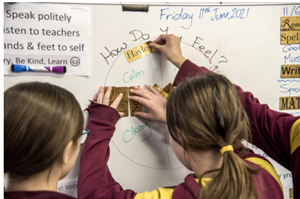Observing children and young people is a great way of getting to know them. Be You supports learning communities with practical strategies to gather information about their mental health and wellbeing. This includes noticing their strengths, behaviours that may cause concern and possible signs of mental health issues.
Understanding why a child or young person behaves a certain way can inform the decisions and planning in relation to the response, especially in a learning community. It’s also important to remain in the boundaries of your role within a learning community, for example the role of the educator isn’t to to diagnose or make conclusions about a child or young person’s state of mental health, as that’s the role of mental health professionals.
Identifying when children and young people need extra support comes down to observations.
When a child or young person’s behaviour has changed without obvious reason or out of character and the change is prolonged, significant or disruptive, this can signal the development of mental health concern or issue.
Some children and young people are at greater risk than others of developing mental health issues, therefore early identification is important. The earlier a child or young person receives support, the better chance they have of overcoming difficulties and reducing the risk of more serious mental health issues.
Observations about a child or young person’s behaviour should:
- focus only on what educators’ see and hear, not on what they think or feel about a child or young person’s behaviour, thoughts or emotions
- record the frequency, the situation and how the child or young person exhibits particular behaviour
- note what factors make the behaviour better or worse
- record the length of time the behaviour or behaviour lasts
- note what happens before and after the behaviour
- be recorded by different educators at different times and in different contexts.
The Be You team has been supporting learning communities using the Be You BETLS Observation Tool to observe student’s behaviour.

The Be You Behaviour, Emotions, Thoughts, Learning and Social Relationships (BETLS) Observation Tool can assist in gathering information and documenting observations about a child or young person’s behaviour by providing a framework to gather and record information in five broad areas:
- Behaviour: what is the child or young person doing?
- Emotions: what might the child or young person be feeling?
- Thoughts: what might the child or young person be thinking?
- Learning: what learning areas are being affected?
- Social relationships: what social areas are being affected?
The BETLS tool also considers:
- pervasiveness: who is present at this time? Where and when does this behaviour occur?
- frequency: how often does it happen?
- persistence: how long has it been happening?
- severity: how much is it influencing a child’s day-to-day experiences?
By observing the nature of a child or young person’s difficulties, the BETLS Observation Tool provides a considered framework to record responses and concerns. This framework may be used to start building an informed and documented discussion in planning a response and or to begin conversations with families about a child or young person’s behaviour.
To find out more or have questions contact us - beyou@headspace.org.au
To learn more about the BELTS Observation Tool
Be You is the national mental health in education initiative led by Beyond Blue, in collaboration with Early Childhood Australia and headspace. Be You supports educators from early learning services and schools to develop a positive, inclusive and resilient learning community where every child, young person, educator and family can achieve their best possible mental health.
To find out more contact beyou@headspace.org.au
To learn more about the BELTS Observation Tool